The Storehouse
You might not even notice the Guldental synagogue if you walk or drive by. From the road, from the pavement, it just looks like some kind of storage building. Only if you took the time to walk around, would you notice the arched windows, and the intricately worked side entrance. This was once a place of worship for a small but very active German-Jewish community. Entering the synagogue today, you see signs of age, past damage and present decay and neglect. But you also sense history: in the Hebrew writing, the decorative roundels in the ceiling, and in the faint echoes of the once warm colours (orange, cream and blue) that graced the walls.
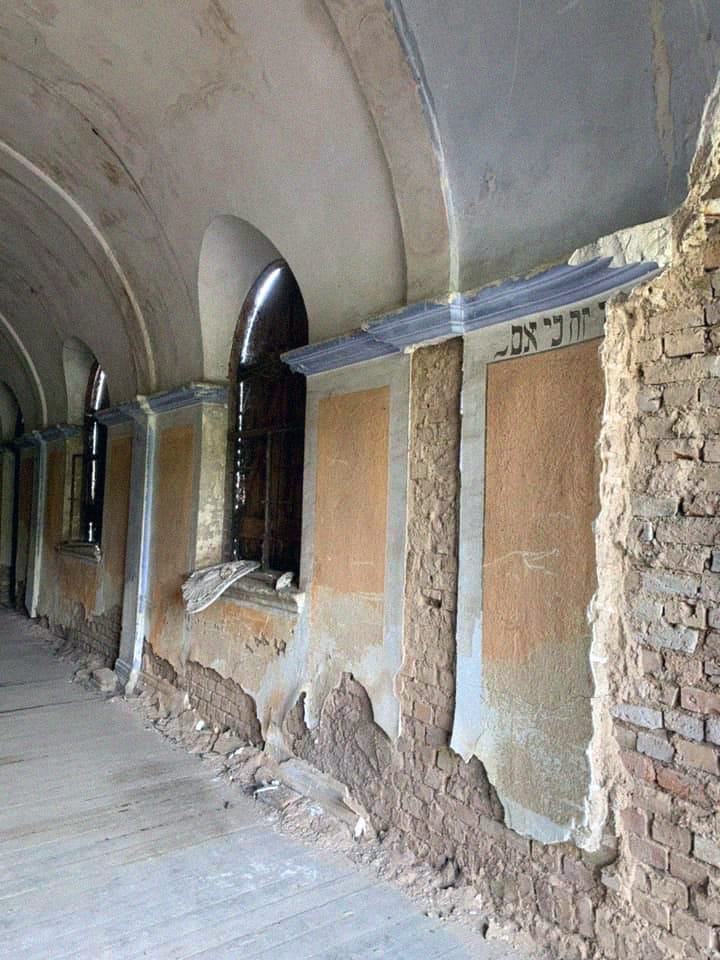 The synagogue in Guldental was opened on 16th September 1910, a simple brick-built building with arched windows. The inauguration took place in the presence of Protestant and Catholic clergy, local teachers as well of course of representatives of the Jewish community including August Schneider who is Hanna Zack Miley’s grandfather. The ceremony ended with a prayer for Kaiser and Reich. The opening then was a sign of the integration and acceptance of the local Jews into the community, a sign of how much they felt they belonged. That all changed when the Nazis came to power in 1933, and on the night of 9th November 1938, the synagogue shared the terrible fate of synagogues throughout Germany and Austria: it was attacked, ransacked, pillaged and badly damaged. The windows and doors were smashed, and the floor ripped up. Today one can see the faint marks where someone scratched the word “Jude” onto one of the walls. In 1939, the ruined building was sold on for a cheap price, and after the war – up to the present day – it was used as a store room for agricultural equipment and as a barn.
The synagogue in Guldental was opened on 16th September 1910, a simple brick-built building with arched windows. The inauguration took place in the presence of Protestant and Catholic clergy, local teachers as well of course of representatives of the Jewish community including August Schneider who is Hanna Zack Miley’s grandfather. The ceremony ended with a prayer for Kaiser and Reich. The opening then was a sign of the integration and acceptance of the local Jews into the community, a sign of how much they felt they belonged. That all changed when the Nazis came to power in 1933, and on the night of 9th November 1938, the synagogue shared the terrible fate of synagogues throughout Germany and Austria: it was attacked, ransacked, pillaged and badly damaged. The windows and doors were smashed, and the floor ripped up. Today one can see the faint marks where someone scratched the word “Jude” onto one of the walls. In 1939, the ruined building was sold on for a cheap price, and after the war – up to the present day – it was used as a store room for agricultural equipment and as a barn.
Rescued From Neglect
A few years ago, a group of local people in Guldental and the surrounding area got together, wanting to rescue the synagogue from neglect. Thanks not least to their commitment, the local council decided only a few weeks ago to purchase the synagogue – unanimously! Soon, it is hoped, the synagogue can be restored and used as a cultural centre, and an exhibition space, informing us about Jewish life in the Heddesheim-Waldhilbersheim area. Locals will have the opportunity to share their stories of how they came to learn about the site.
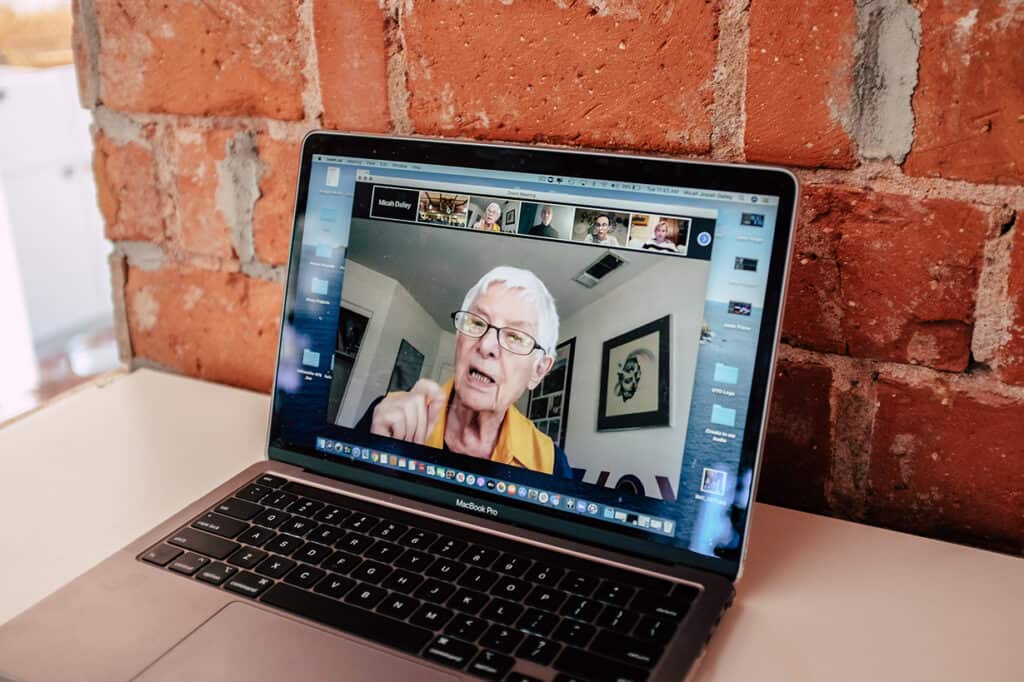 Only a short time before the local council decided to buy the synagogue, we participated in a Zoom meeting which took place in the local church. Pastor Holger Werries and Prince Michael zu Salm-Salm helped to make it possible. Locals of the Guldental area were able to meet and chat to Hanna, who was zooming from across the Atlantic from Arizona. Bill thought that “it was remarkable to hear the locals speak of the synagogue and of Guldental’s Jewish past, and what this all meant to them: in no time at all an emotional bridge spanned the physical distance to Hanna, who, at the end of the meeting, spoke a blessing. There was a sense of conciliation, community and reconnection”. Amy felt that it was “great to see Hanna connect with local German citizens in the place where her mother, aunts and grandparents once lived”. Amy remembers that she was happily listening to and reading Bill and Cecily’s translations of the conversations when all of a sudden she was asked to introduce herself. She said that she was “very thankful for this invitation because it was wonderful to explain how we became connected with the synagogue project”. Amy also emphasised how important this project was to British academics. She described to everyone present how Hanna’s story is featured in an open-air bilingual travelling Kindertransport exhibition that she and Bill curated with PhotoWerk Berlin and Dr. Andrea Hammel in 2019. The exhibition was just about to be opened at the synagogue so Amy provided an overview as to what the exhibition focusses on and how it came about in the first place.
Only a short time before the local council decided to buy the synagogue, we participated in a Zoom meeting which took place in the local church. Pastor Holger Werries and Prince Michael zu Salm-Salm helped to make it possible. Locals of the Guldental area were able to meet and chat to Hanna, who was zooming from across the Atlantic from Arizona. Bill thought that “it was remarkable to hear the locals speak of the synagogue and of Guldental’s Jewish past, and what this all meant to them: in no time at all an emotional bridge spanned the physical distance to Hanna, who, at the end of the meeting, spoke a blessing. There was a sense of conciliation, community and reconnection”. Amy felt that it was “great to see Hanna connect with local German citizens in the place where her mother, aunts and grandparents once lived”. Amy remembers that she was happily listening to and reading Bill and Cecily’s translations of the conversations when all of a sudden she was asked to introduce herself. She said that she was “very thankful for this invitation because it was wonderful to explain how we became connected with the synagogue project”. Amy also emphasised how important this project was to British academics. She described to everyone present how Hanna’s story is featured in an open-air bilingual travelling Kindertransport exhibition that she and Bill curated with PhotoWerk Berlin and Dr. Andrea Hammel in 2019. The exhibition was just about to be opened at the synagogue so Amy provided an overview as to what the exhibition focusses on and how it came about in the first place.
We had been invited and asked to display our work at the British Embassy in Berlin to commemorate the 80th anniversary of the Kindertransport by Sophie Bechner. After the talks to remember the anniversary we meet with Norbert Wiesner who wanted to create the first German-British Kindertransport exhibition to go on show in Germany. The exhibition that developed from this is called “At the End of the Tunnel” and has now arrived in Guldental.
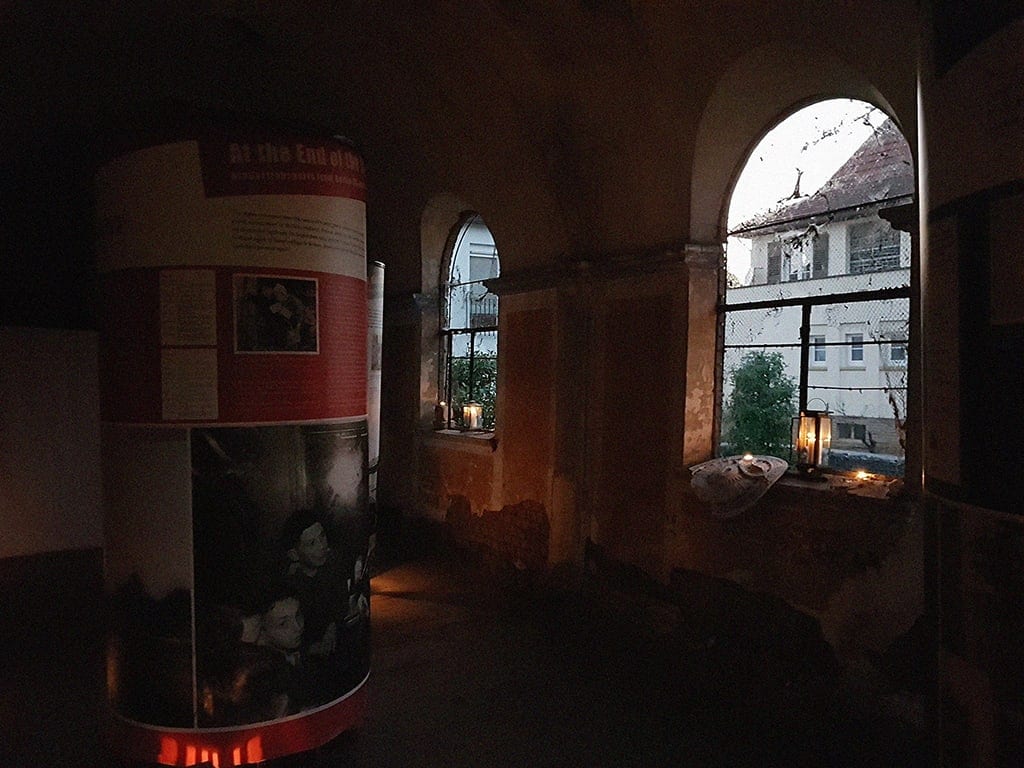
We had both been very much looking forward to the planned commemorative event in Guldental to remember Kristallnacht on 9th November 2020. Unfortunately it had to be cancelled because of lockdown in Germany and Britain. But thanks to Patricia, Karen and Holger, a small intimate lighting ceremony was organised. We were able to be there in spirit, because they kindly sent us photographs of the synagogue illuminated by candle light. It was so beautiful that they were able to open the windows so that the last light of the day entered to adorn the walls. A graceful peace seemed to set in, which was felt miles away when we lit our own candles in our homes to remember the tragic events of Kristallnacht and the Jewish victims. While we remembered this painful event, we were reminded of the coming together of the local and international community today who are helping to breathe new life into the synagogue, retrieve its history and restore its standing within the community.
The Cultural Centre and Exhibition Space
We suggested creating a new temporary exhibition focussing on the history of Jewish life in Guldental and the surrounding area as well as on the synagogue because it is so important to give a voice to these stories. We want to connect a local story with the international community because there is still so much to learn. These local stories can shed light on a forgotten local past but they also hold so much significance in terms of the broader history and memory of the Kindertransport for example. We are thinking the exhibition could be displayed on fabric banners hanging from the synagogue walls. All in all we would envisage 6-9 banners to be displayed around the inside of the synagogue. We would suggest the following structure to the committee but we also love for them to adapt it and put forward their ideas;
- Banner One – Introduction – basic facts and images
- Banner Two – The history of the synagogue and cemetery
- Banner Three – Hanna’s family’s story – Grandfather helping to found the synagogue
- Banner Four – Hanna’s Kindertransport story
- Banner Five – Kristallnacht
- Banner Six – Emigration from Guldental and the later lives of Jews from the area
- Banner Seven – Breathing new life into the synagogue
- Banner Eight – The community today – conciliation and looking to the future
- Banner Nine – Creative response by Caroline Slifkin
We think 9 banners would be symbolic because the synagogue was vandalised on the 9th November 1938 during the events of Kristallnacht and this date connected all of us because of the virtual event that took place to commemorate the anniversary. We hope to interweave stories throughout the banners. By creating Hanna’s banners first it might help us to structure and develop our ideas for the rest of the exhibition. It would be great to have Hanna’s banners up earlier next year to connect with the “At the End of the Tunnel” exhibition currently on display at the synagogue. We also want to make archival material relating to the synagogue available to the public. So we would like to create a website which showcases this but also allows the public to comment or send us items. The project aims to keep people updated with the synagogue’s refurbishment, how the physical exhibition is coming along and local stories in the area. The website could be used to advertise events, host blogs, online exhibitions, and a gallery where we can upload photos.
Reconnection, Restoration, and Redemption
In the town archive, looked after by Margarete Hargarten, we read through documents relating that religious objects inside the synagogue had been looted or destroyed such as Hanukkah candles. The doors and the windows had been very badly smashed. Soon though these doors and windows will be repaired and people will be able to learn about the history of the synagogue from inside a space which has lived many different lives. What the Zoom meeting showed us is that many people from all different backgrounds have a deep connection to the synagogue and want to express that connection and in cases such as Hanna a reconnection. Hanna has a personal connection to the site through her family history, Amy has a connection through her relationship with Hanna and her research on the Kindertransport, and Bill has a connection because he lives near the synagogue and also through his research on facing the Nazi past.
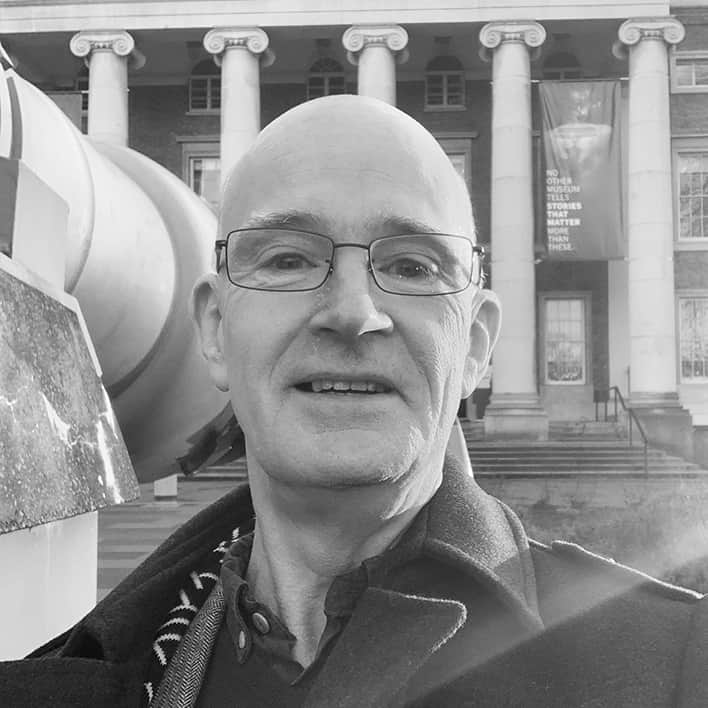
Bill Niven
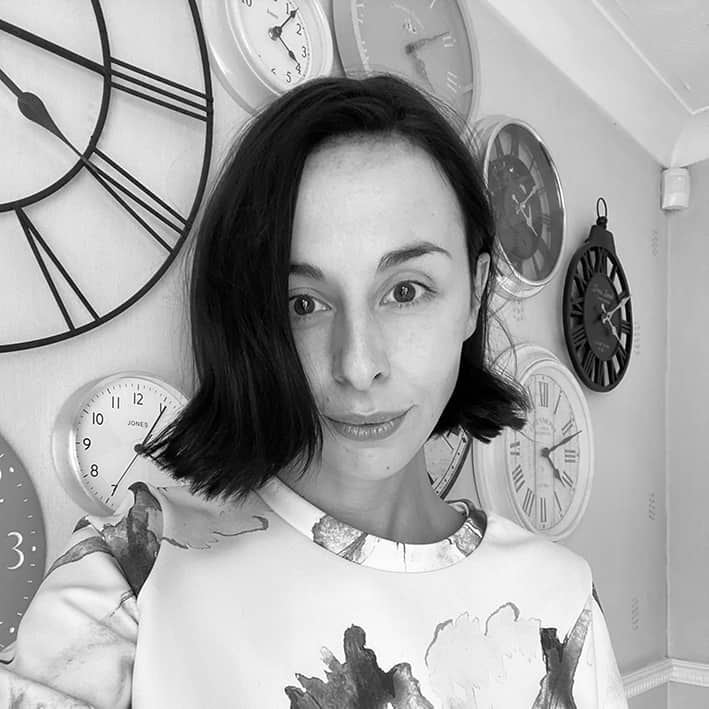
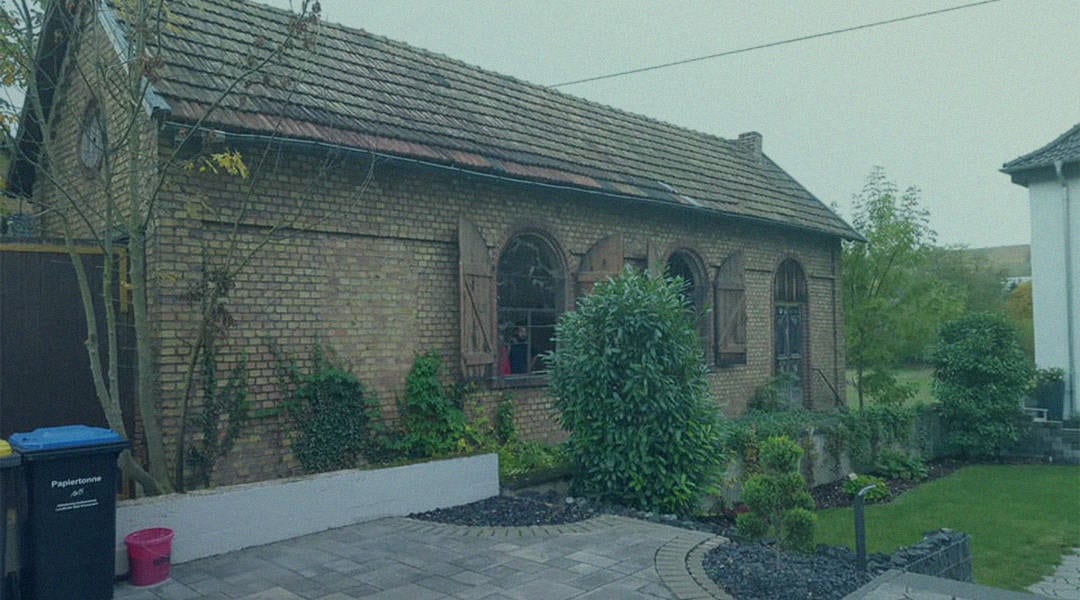
Its such a wonderful treasure that this building is being repurposed! Thank you for your work and commitment, Amy and Bill!
Meeting Hanna the first time, was a very special moment for me, I trink, for all of us. Thank you all so much for your support,
Hanna, Bill, Amy, Cecily, Holger, Michael.